
Weatherby, Inc. is an American gun manufacturer founded in 1945 by Roy Weatherby. The company is best known for its high-powered magnum cartridges, such as the .257 Weatherby Magnum, .270 Weatherby Magnum, .300 Weatherby Magnum, .340 Weatherby Magnum and the .460 Weatherby Magnum. The company's headquarters is in Sheridan, Wyoming.
Savage Arms is an American gunmaker based in Westfield, Massachusetts, with operations in Canada and China. Savage makes a variety of rimfire and centerfire rifles, as well as Stevens single-shot rifles and shotguns. The company is best known for the Model 99 lever-action rifle, no longer in production, and the .300 Savage. Savage was a subsidiary of Vista Outdoor until 2019 when it was spun off.
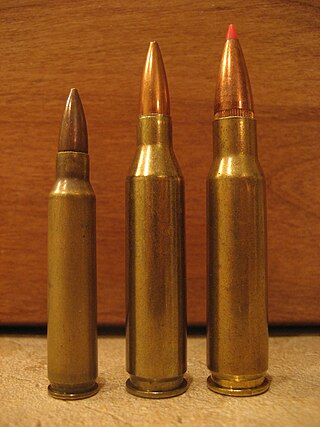
The .243 Winchester (6×52mm) is a popular sporting rifle cartridge. Developed as a versatile short action cartridge to hunt both medium game and small game alike, it "took whitetail hunting by storm" when introduced in 1955, and remains one of the most popular whitetail deer cartridges. It is also commonly used for harvesting blacktail deer, pronghorns and mule deer with heavier rounds, and is equally suited to varmint hunting with lighter rounds. The .243 is based on a necked down .308 Winchester, introduced only three years earlier. Expanding monolithic copper bullets of approximately 80 to 85 grains or traditional lead rounds of 90 to 105 grains with controlled expansion designs are best suited for hunting medium game, while lighter rounds are intended for varmints.
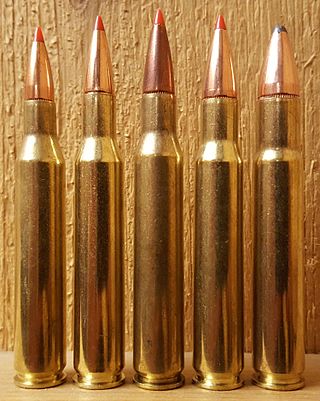
The .270 Winchester is a rifle cartridge developed by Winchester Repeating Arms Company in 1923, and it was unveiled in 1925 as a chambering for their bolt-action Model 54 to become arguably the flattest shooting cartridge of its day, only competing with the .300 Holland & Holland Magnum, also introduced in the same year.
Marlin Firearms is an American manufacturer of semi-automatic, lever-action and bolt-action rifles. In the past the company made shotguns, derringers, and revolvers. Marlin owned the firearm manufacturer H&R Firearms. In 2007, Remington Arms, part of the Remington Outdoor Company, acquired Marlin Firearms. Remington produced Marlin-brand firearms at its Kentucky and New York manufacturing facilities. In 2020, Sturm, Ruger & Co. bought the Marlin business from bankrupt Remington Outdoor Company.

The 9.3×62mm is a rimless, bottlenecked rifle cartridge designed in 1905 by German gunmaker Otto Bock. It is suitable for hunting medium to large game animals in Africa, Asia, Europe, and North America. At a typical velocity of 720 m/s (2362 ft/s), its 286 gr standard load balances recoil and power for effective use at 250m to 300m. The C.I.P. Maximum Average Pressure (MAP) for the 9.3×62mm is 390.00 MPa (56,565 psi).
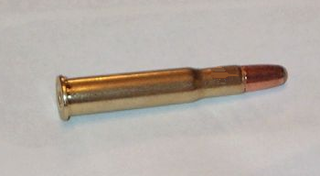
The .30-30 Winchester cartridge was first marketed for the Winchester Model 1894 lever-action rifle in 1895. The .30-30, as it is most commonly known, along with the .25-35 Winchester, was offered that year as the United States' first small-bore sporting rifle cartridges designed for smokeless powder. Since its introduction, it has been utilized alongside the development of flatter shooting cartridges, most prominently those derived from designs subsidized by interest in military expenditures. The .30-30 has remained in widespread use almost entirely because of reliable effectiveness in civilian applications, and has put food on the table for millions of people in hunting situations.
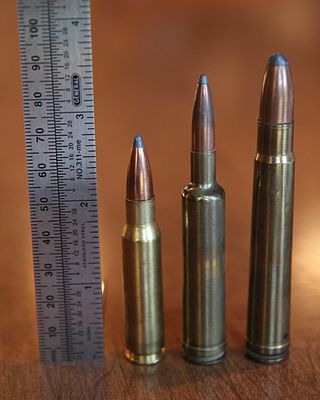
The .257 Weatherby Magnum is a .257 caliber (6.53 mm) belted bottlenecked cartridge. It is one of the original standard length magnums developed by shortening the .375 H&H Magnum case to approx. 2.5 in (64 mm). Of the cartridges developed by Roy Weatherby, the .257 Weatherby Magnum was known to have been his favorite, and the cartridge currently ranks third in Weatherby cartridge sales, after the .30-378 Weatherby Magnum and the .300 Weatherby Magnum.

The .375 H&H Magnum, also known as .375 Holland & Holland Magnum, is a medium-bore rifle cartridge introduced in 1912 by London based gunmaker Holland & Holland. The .375 H&H cartridge featured a belt to ensure the correct headspace, which otherwise might be unreliable, given the narrow shoulder of the cartridge case. The cartridge was designed to use cordite which was made in long strands – hence the tapered shape of the case, which, as a beneficial side effect also helped in smooth chambering and extraction from a rifle's breech.
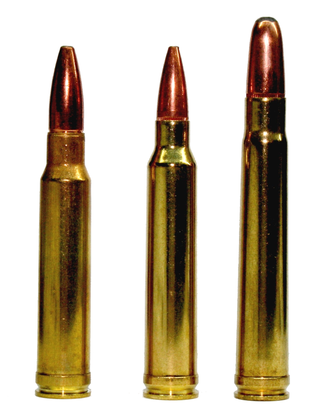
The .300 Winchester Magnum is a belted, bottlenecked magnum rifle cartridge that was introduced by the Winchester Repeating Arms Company in 1963. The .300 Winchester Magnum is a magnum cartridge designed to fit in a standard rifle action. It is based on the .375 H&H Magnum, which has been blown out, shortened, and necked down to accept a .30 caliber (7.62 mm) bullet.
The Winchester Model 1894 rifle is a lever-action repeating rifle that became one of the most famous and popular hunting rifles of all time. It was designed by John Browning in 1894 and originally chambered to fire two metallic black powder cartridges, the .32-40 Winchester and .38-55 Winchester. It was the first rifle to chamber the smokeless powder round, the .30 WCF in 1895. In 1901, Winchester created the new .32 Winchester Special caliber with production of rifles starting in 1902.
The 5.6×57mm cartridge was created by Rheinisch-Westfälische Sprengstoffwerke (RWS) in Germany in 1964 by necking down popular 7×57mm Mauser for hunting small deer such as roe deer, and for chamois. The calibre has a significant following among European sportsmen, and most European mass production riflemakers chamber several models of rifle for this cartridge. During the 1970-1990 period this cartridge was widely and successfully used in the Republic of Ireland for deer shooting, since security considerations at a period of Provisional Irish Republican Army violence had led to a ban on the civilian ownership of calibres larger than .224in. Some British small deer specialist hunters use the 5.6×57 mm with great success on roe deer, muntjac and Chinese water deer.
The .264 Winchester Magnum is a belted, bottlenecked rifle cartridge. Except for the .244 H&H Magnum and .257 Weatherby Magnum, it is the smallest caliber factory cartridge derived from the 2.85 in (72 mm) Holland & Holland belted magnum case. It was introduced in the late 1950s and early 1960s with the .338 Winchester Magnum and the .458 Winchester Magnum as one of a family of short-cased 2.5 in (64 mm) belted magnum cartridges developed by Winchester based on the .375 Holland & Holland parent case. It was officially introduced to the public by Winchester in 1959. After many years of dwindling use it began enjoying a mild resurgence in popularity in the mid-2000s among long range rifle enthusiasts and reloaders due to the high ballistic coefficient of the heavier 6.5mm bullets and increasing popularity of cartridges such as 6.5mm Creedmoor, .260 Remington, 6.5 Grendel, benchrest and wildcat cartridges in 6.5mm.

The .244 Holland & Holland Magnum cartridge was created in 1955 in Great Britain by deerstalker and rifle-maker David Lloyd of Pipewell Hall, Northamptonshire and Glencassley in Sutherland, Scotland, and is not to be confused with the smaller-cased and much milder 6 mm Remington. Stalking on extremely steep deer forests such as his own at Glencassley, Lloyd was in search of a "canyon rifle" cartridge that would shoot exceptionally fast and with a very flat trajectory across deep valleys and over distances out to 300 yards (270 m) and more, to make range estimation less critical for accurate bullet placement, and to deliver a hard-hitting bullet weighing a minimum of 100 grains. The .244 H&H Magnum easily met these criteria.
The Lloyd Rifle was the 1950s brainchild of English deer-stalker, rifleman, metallurgist and engineer David Llewellyn Lloyd. His objective was to create a high-quality, scope-sighted, magazine-fed sporting rifle capable of dependably high accuracy at long ranges, of retaining its zero despite rough handling, and of firing modern high-intensity, flat shooting cartridges such as the .244 H&H Magnum and the .264 Winchester Magnum.
Roy Edward Weatherby, was the founder and owner of Weatherby, Inc., an American rifle, shotgun and cartridge manufacturing company founded 1945. Weatherby created an entire line of custom cartridges, and was one of the people responsible for the industry interest in high-speed cartridges. He created a custom rifle action to accommodate his high-pressure cartridges.

John Rigby & Company is a gunmaking firm founded by John Rigby in 1775 in Dublin. The company was established by the first John Rigby in Dublin, Ireland, apparently in 1775; his grandson, also John, opened a London branch in 1865; and Dublin operations had ceased by February 1897. The company is now owned by Lüke & Ortmeier Gruppe and is based in Vauxhall, central London, under the supervision of managing director, Marc Newton.
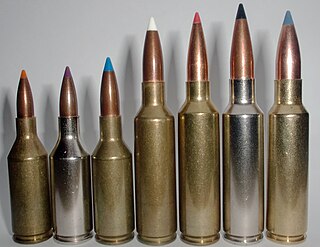
The .325 Winchester Short Magnum, commonly known as the 325 WSM, is an 8mm caliber rebated rim bottlenecked centerfire short magnum medium bore cartridge. The cartridge was introduced by Winchester Ammunition in 2005.
The .375 Dakota is dangerous game cartridge designed by Don Allen, the founder of Dakota Arms of Sturgis, South Dakota.
The Sako 75 is a bolt-action rifle produced by the Finnish manufacturer Sako from 1996 until it was replaced by its successor, the Sako 85 in 2006, and finally discontinued in 2007.










